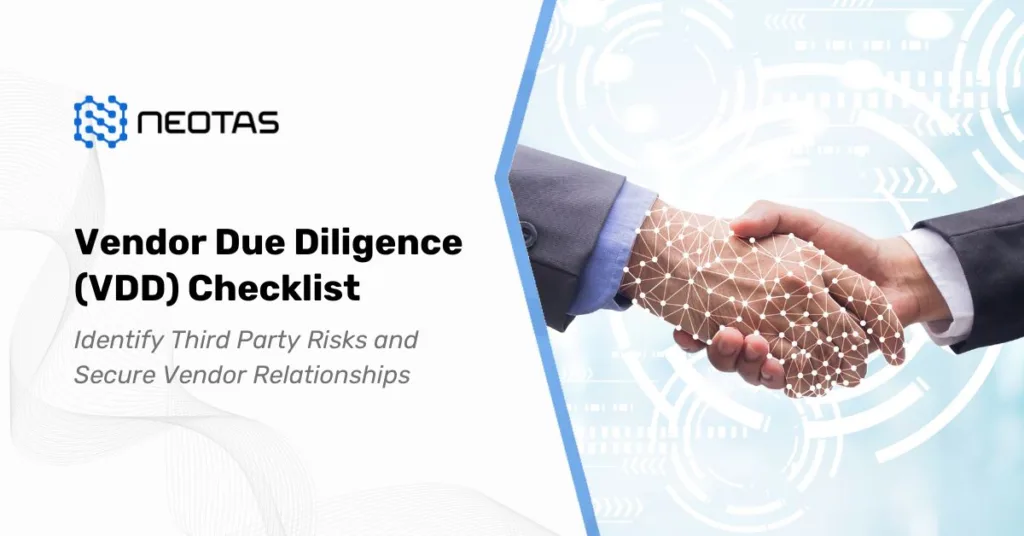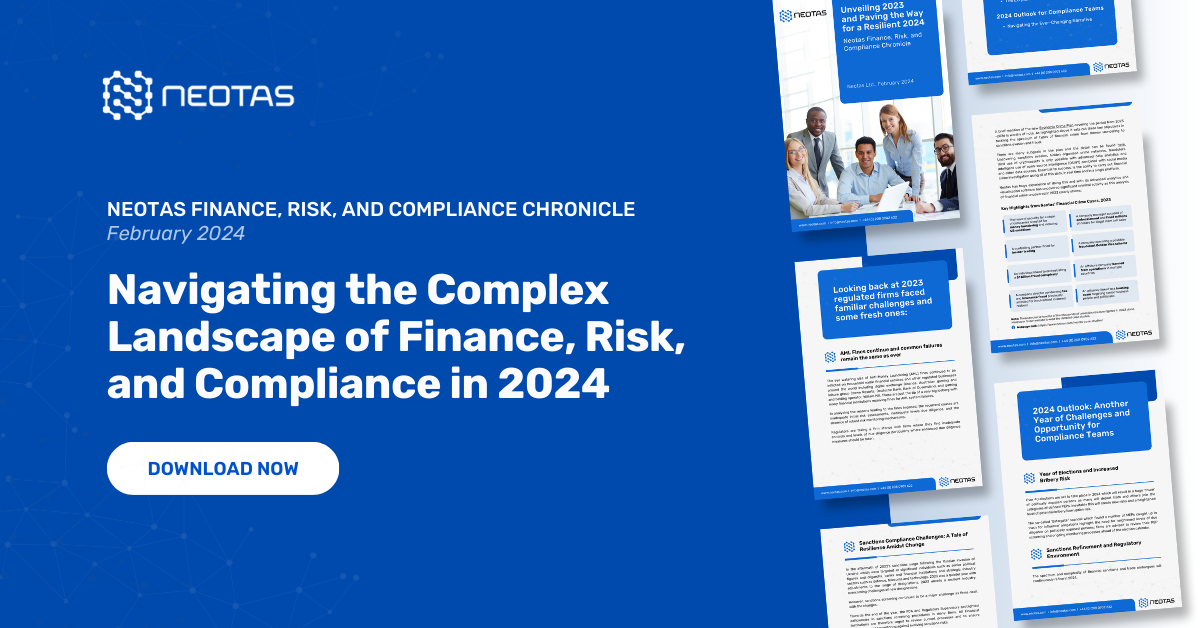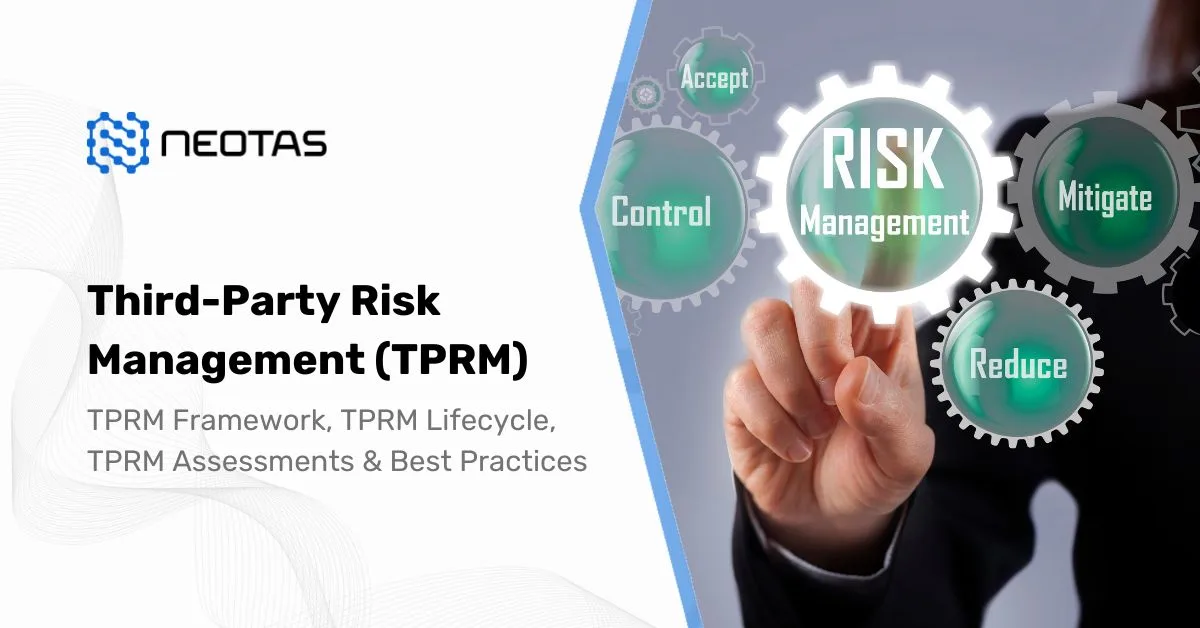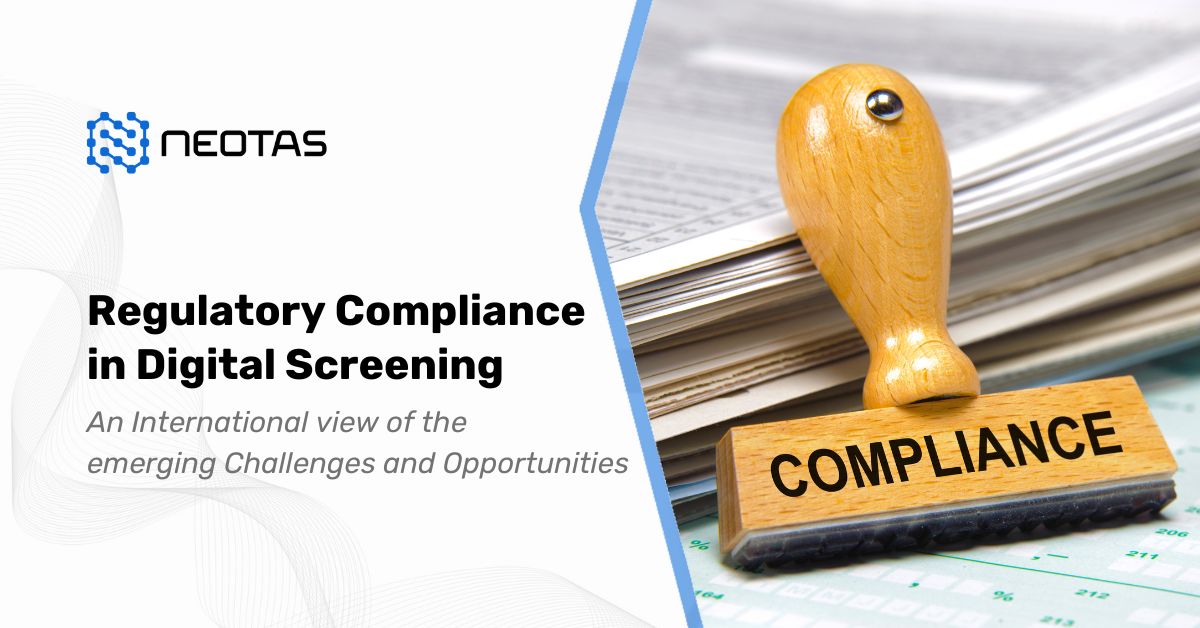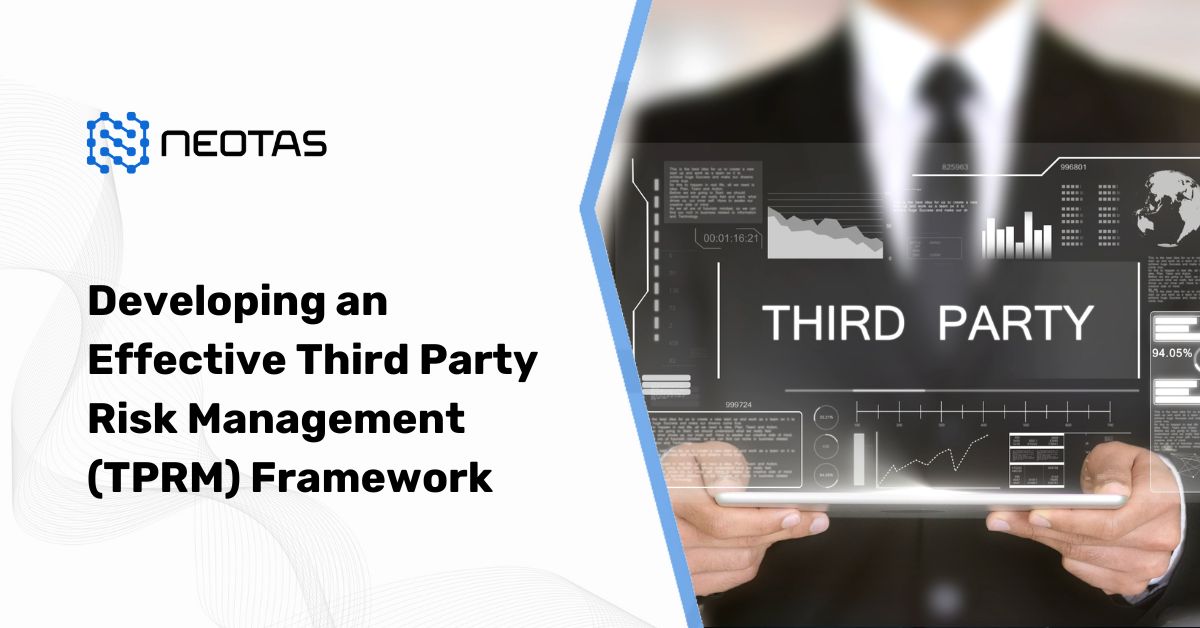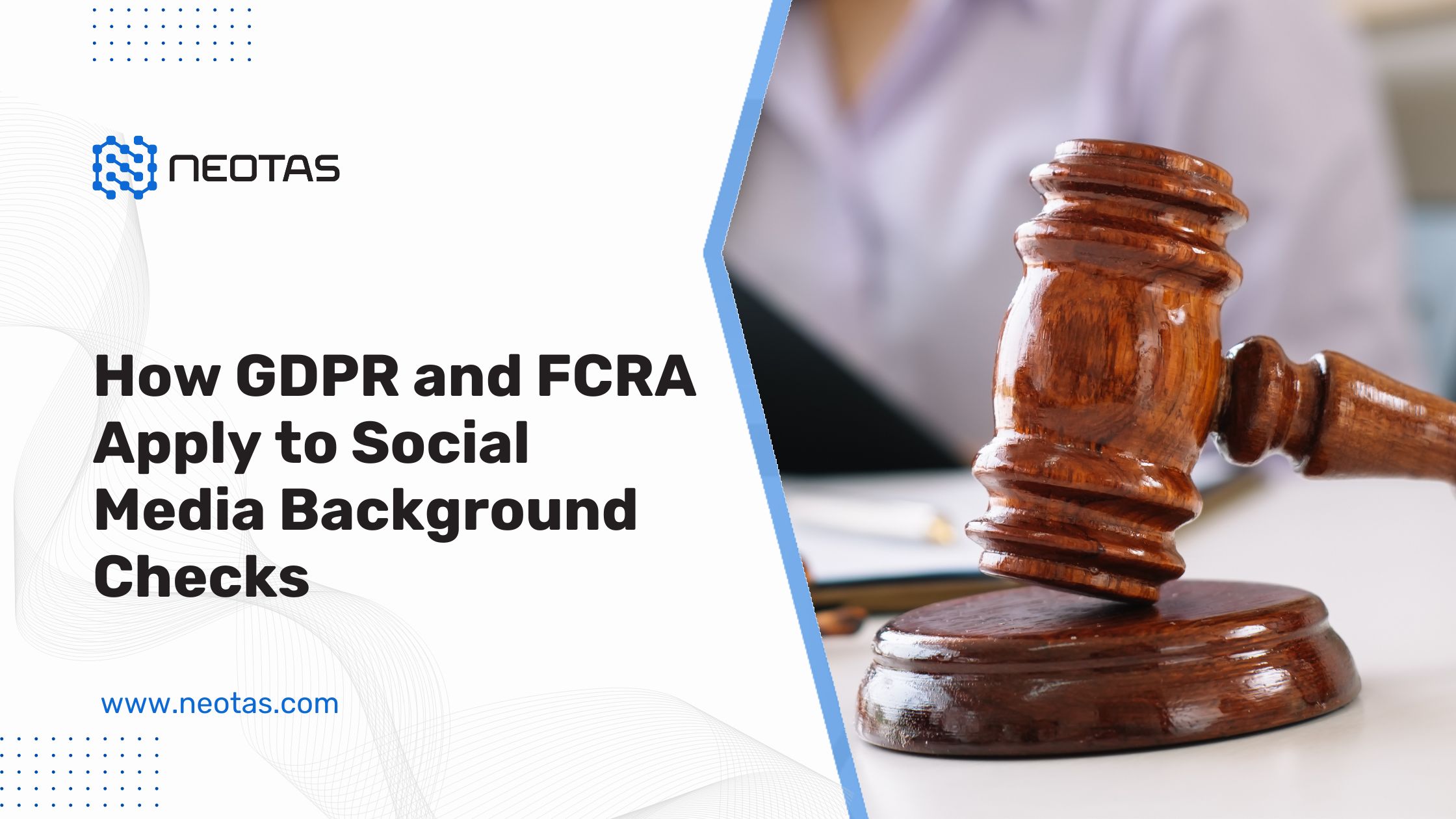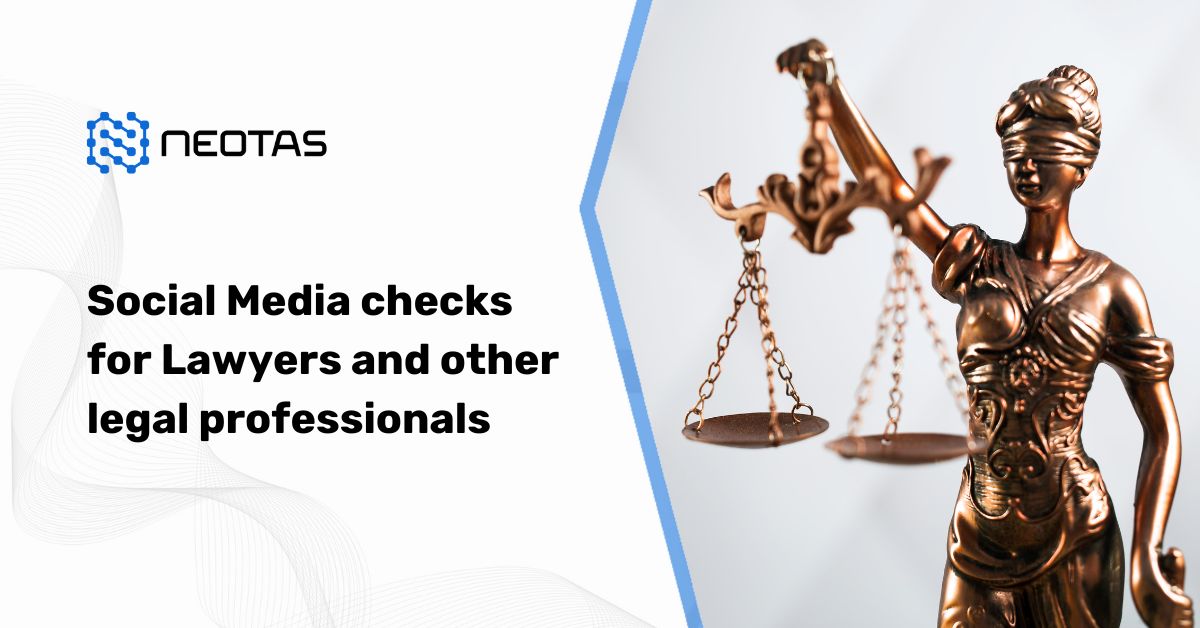Vendor Due Diligence Checklist
Identify Third Party Risks and Secure Vendor Relationships with Vendor Due Diligence
Vendor due diligence (VDD) is a systematic process of evidence-gathering and assessment undertaken by companies to evaluate potential partners or acquisition prospects.
Vendor Due Diligence (VDD) offers crucial information about a potential partner’s business methods and adherence to laws and regulations. It focuses on financial, legal, operational, and regulatory factors, as well as reputation, which can all significantly affect the success and value of a business agreement. It ensures transparent and detailed financial representations from sellers to buyers, bolstering buyer confidence and providing a clear understanding of the business’s financial health.
What is Vendor Due Diligence (VDD)?
Vendor Due Diligence (VDD) is a critical process in business transactions, particularly in mergers, acquisitions, and corporate sales. When a company decides to sell its shares or assets, it’s essential that potential buyers are meticulously evaluated. This is where VDD becomes pivotal. It serves as a comprehensive investigation conducted to scrutinise the viability, ethics, and robustness of potential buyers or partners.
Primarily utilised by financial institutions, VDD reports are instrumental in evaluating potential vendors, ensuring they uphold ethical standards and possess strong financial and operational health. The importance of VDD extends beyond mere financial evaluation; it’s a key tool in mitigating operational, compliance, and reputational risks. This is especially vital in the context of Anti-Money Laundering (AML) and Counter-Terrorism Financing (CTF), where understanding the integrity and legality of business partners is paramount.
The preparation of a Vendor Due Diligence Report typically involves an external, independent third party. This report, detailed and thorough, is subsequently presented to prospective investors or buyers. It offers an in-depth analysis of the target company’s financial stability, operational efficiency, legal standing, and overall market position.
Prospective buyers leverage this report to assess the company’s valuation, unearthing any potential risks or challenges that could impact their investment decision. Importantly, the report facilitates the identification and resolution of any critical issues by the seller before proceeding with the sale. Addressing these issues proactively, particularly financial discrepancies or legal complications, can significantly smoothen the sales process.
Conducting VDD at an early stage, preferably before initiating the sales process, is highly beneficial. This proactive approach allows for the rectification of significant financial concerns or other findings that could otherwise hinder the sale. It’s not just a matter of evaluating the current state but also involves forecasting potential future challenges and opportunities, providing both sellers and buyers with a clearer picture of the transaction’s viability.
Vendor Due Diligence Objectives
Vendor Due Diligence (VDD) is pivotal for both sellers and buyers in the business transaction process. Primarily, VDD serves as a strategic tool that enhances transparency and informs decision-making.
Below are the detailed objectives of VDD:
- In-depth Analysis of Business Challenges: VDD involves a thorough examination of a company’s underlying challenges. This detailed scrutiny enables sellers to address any issues proactively, thus presenting their business in the most favourable light.
- Optimising Sale Value: Through VDD, sellers can showcase their business’s strengths effectively, potentially leading to a maximised sale price. It provides a clear picture of the business’s value, assisting sellers in securing the best possible price in the market.
- Identification of Key Business Drivers: VDD helps in identifying the critical elements that drive a company’s future performance. This includes evaluating operational efficiencies, market positioning, and growth potentials, which are crucial for informed decision-making.
- Enhancing Purchase Price: By highlighting the strengths and mitigating the risks within the business, VDD can contribute to an increased purchase price. It offers buyers a more comprehensive understanding of the business’s value, thereby justifying a higher offer.
- Risk Assessment for Buyers: VDD allows buyers to perceive potential risks within the organisation comprehensively. This risk evaluation includes financial, legal, operational, and market-based risks, providing a balanced view of the company’s position.
- Refinement of Business Plans: The process of VDD enables businesses to fine-tune their strategies and operational plans. By uncovering areas for improvement, companies can develop more robust and effective business models.
- Improvement in Offer Quality: For sellers, VDD can lead to receiving higher quality offers from buyers. As it lays out a clear and honest picture of the business, it attracts serious buyers who are willing to make well-informed and competitive offers.
Vendor Due Diligence is a critical component of the sales process, offering comprehensive insights that benefit both sellers and buyers. It underpins the transaction’s success by ensuring clarity, mitigating risks, and ultimately contributing to the realisation of the business’s true value.
Vendor Due Diligence vs. Traditional Due Diligence
This table outlines the key differences between Vendor Due Diligence and Traditional Due Diligence, highlighting their distinct roles, objectives, and impacts on business transactions.
| Aspect | Vendor Due Diligence (VDD) | Traditional Due Diligence |
|---|---|---|
| Purpose | Primarily seller-driven to present a comprehensive view of their business to potential buyers. | Buyer-initiated to assess risks and validate information provided by the seller. |
| Focus | Aims to showcase the business’s strengths and address potential weaknesses. | Concentrates on uncovering risks and validating the business’s worth. |
| Initiation | Initiated by the seller before the sale process. | Initiated by the buyer once a potential acquisition target is identified. |
| Control | Seller has more control over the process and the information disclosed. | The buyer controls the scope and depth of the investigation. |
| Objective | To increase transparency, streamline the sales process, and potentially elevate the business’s value. | To protect the buyer’s interests by thoroughly understanding the business and its potential liabilities. |
| Reporting | Produces a report shared with potential buyers, often aiding in speeding up the buyer’s due diligence process. | Resulting reports are typically for the buyer’s use to inform their decision-making process. |
| Impact on Transaction | Can positively impact the transaction by providing clarity and building trust with potential buyers. | Aims to inform the buyer, possibly affecting the negotiation terms or the decision to proceed with the transaction. |
| Typical Usage | Common in mergers and acquisitions, especially when the seller expects multiple bidders. | Used in various transactions, including mergers, acquisitions, and investments, primarily driven by the buyer’s need for information. |
| Timeframe | Generally conducted before the business is put on the market. | Conducted after initial interest or intent to purchase is expressed by the buyer. |
| Scope of Information | Broad scope, covering various aspects of the business as prepared by the seller. | Specific to the buyer’s concerns and interests, potentially more focused in scope. |
Why is Vendor Due Diligence important?
Businesses engage in Vendor Due Diligence (VDD) as a strategic practice to ensure informed decision-making and to mitigate risks associated with third-party relationships. This comprehensive process offers a multitude of benefits:
- Risk Management: The essence of VDD lies in its ability to identify and assess risks, protecting the business from potential financial losses, legal complications, and damage to its reputation. By thoroughly vetting vendors, companies can avert the pitfalls of associating with entities that are non-compliant or engage in fraudulent activities.
- Regulatory Compliance: Compliance with legal and regulatory frameworks is non-negotiable, especially in industries like finance, healthcare, and defense. VDD is instrumental in ensuring that all third-party relationships align with these stringent requirements, thereby maintaining legal and ethical standards.
- Valuation and Transaction Outcome: A critical function of VDD is to unearth any hidden liabilities or financial discrepancies that might affect the valuation of a business partnership or acquisition. This deep dive into the vendor’s affairs helps in accurately gauging the potential value and outcome of a deal.
- Fostering Trust and Transparency: Trust is the cornerstone of any successful business relationship. VDD fosters this trust by providing a clear, objective, and comprehensive analysis of a vendor’s operational capabilities, performance metrics, and adherence to compliance standards.
- Operational Efficiency: In the pursuit of efficient operations, VDD streamlines the process of selecting vendors. It equips businesses with the necessary insights to identify and engage with high-caliber partners swiftly, thereby enhancing operational efficiency.
Who Prepares Vendor Due Diligence Reports?
The preparation of VDD reports are typically compiled by seasoned third-party auditors. These auditors are engaged by the vendor under scrutiny to conduct an independent and thorough analysis of their business. The responsibility for initiating and facilitating this independent evaluation falls on the entity being sold, partnered with, or acquired. The resultant report is then furnished to prospective buyers and other relevant parties, offering them an invaluable resource in their decision-making process.
Preparing for Vendor Due Diligence
- The Role of Company Management and Advisors:
- Company Management: They are pivotal in leading the due diligence process, ensuring the accuracy and completeness of information. Management should demonstrate a thorough understanding of the business’s operational, financial, and strategic aspects.
- Advisors: Professional advisors, such as lawyers, accountants, and financial consultants, play a crucial role. They guide the process, ensuring compliance with legal standards, financial accuracy, and strategic alignment. They also help in identifying and addressing areas that might concern buyers.
- Gathering and Organising Relevant Documentation:
- Documentation Collection: Assemble all critical documents, including financial statements, legal contracts, business plans, and compliance certificates.
- Organising: Documents should be systematically organised, preferably in a digital data room, for easy access and review. This helps in presenting a transparent and efficient overview of the business to potential buyers.
- Anticipating Potential Buyer Concerns:
- Market Analysis: Understand the market dynamics and how they might influence the buyer’s perspective.
- Risk Assessment: Conduct an internal review to identify any operational, financial, or legal risks that might be of concern to buyers.
- Mitigation Strategies: Develop strategies to mitigate identified risks, or prepare justifications and explanations for unavoidable risks.
- Understanding the Importance of Accurate and Timely Information:
- Accuracy: Ensure that all information provided is accurate and verifiable. Inaccuracies can lead to distrust and could jeopardise the deal.
- Timeliness: Information should be current and updated. Outdated information can lead to incorrect valuations and decisions.
- Continual Updates: Be prepared to provide ongoing updates throughout the due diligence process. This demonstrates transparency and responsiveness to buyer queries.
By focusing on these areas, companies can effectively prepare for Vendor Due Diligence, enhancing the potential for a successful transaction.
What is the Vendor Due Diligence Process?
The Vendor Due Diligence (VDD) process is a comprehensive and systematic approach undertaken typically by a seller to evaluate and present their business in an accurate and detailed manner to potential buyers or investors. The process involves several key steps:
- Preparation Phase:
- Identifying Objectives: Establishing the goals of the VDD, such as enhancing the sale process or identifying potential deal breakers.
- Gathering Documentation: Collecting relevant financial, operational, legal, and other necessary documents.
- Evaluation and Analysis:
- Financial Analysis: Reviewing financial statements, assessing financial health, and understanding revenue streams.
- Operational Review: Evaluating operational processes, efficiency, and productivity.
- Legal Compliance Check: Examining legal compliances, contract obligations, and any litigation issues.
- Market Analysis: Assessing the company’s market position, competition, and industry trends.
- IT and Cybersecurity Assessment: Reviewing IT infrastructure and cybersecurity measures.
- Human Resources Evaluation: Looking into workforce structure, culture, and HR policies.
- Reporting:
- Drafting the Report: Compiling findings into a comprehensive VDD report. This report typically includes an executive summary, detailed analysis, and conclusions.
- Review and Revision: Going through a process of review and revisions to ensure accuracy and completeness.
- Disclosure and Negotiation:
- Sharing the Report: Providing the VDD report to potential buyers or investors.
- Addressing Queries: Responding to any questions or clarifications from the potential buyers based on the report.
- Negotiations: Using the findings of the VDD in sale negotiations.
- Post-Due Diligence Activities:
- Finalising the Deal: Concluding sale or investment agreements based on the due diligence outcomes.
- Transition and Integration Support: Assisting in the transition or integration process post-deal, if applicable.
Throughout this process, the VDD aims to create transparency, build trust, and facilitate a smoother transaction by providing a clear, detailed view of the business to potential buyers.
Scope of Vendor Due Diligence
| Scope Area | Detailed Exploration |
|---|---|
| Financial Aspects | Detailed scrutiny of the company’s financial health, encompassing an in-depth analysis of financial statements, identifying trends and patterns in financial performance over time, and evaluating forward-looking financial projections. This includes a comprehensive review of revenue streams, profitability, cost structures, and capital expenditure. |
| Operational Aspects | Thorough evaluation of the organisational structure, encompassing an assessment of operational processes, efficiency, and risk management strategies. This also involves a critical review of the company’s product or service offerings, examining their market fit and competitiveness, alongside an analysis of key client and supplier relationships, focusing on their stability and long-term sustainability. |
| Legal and Compliance Aspects | Rigorous examination of the company’s legal framework and structure, including a review of ownership, subsidiary arrangements, and corporate governance. Compliance with relevant laws and regulations, including industry-specific requirements, is carefully scrutinised. Additionally, the company’s litigation history, if any, is examined to assess potential legal risks or ongoing liabilities. |
| Market Environment | In-depth analysis of the company’s position within the market, comparing it with key competitors to understand its competitive edge and market share. This includes studying current and emerging industry trends, challenges, and opportunities, providing insights into the company’s future market positioning. |
| IT and Cybersecurity | Comprehensive assessment of the company’s IT infrastructure and technology systems, focusing on their robustness, scalability, and alignment with current technological advancements. Cybersecurity measures are critically evaluated, ensuring robust data protection and compliance with data privacy laws and regulations. |
| Human Resources | A detailed review of the company’s workforce, including analyses of skills, experience levels, and distribution across the organisation. The company culture, employee engagement levels, and human resources policies are closely examined to gauge workforce stability and the effectiveness of talent management practices. |
VDD for Different Stakeholders
- VDD from a Seller’s Perspective
- VDD for Prospective Buyers
- VDD for The Company (being assessed)
- VDD Considerations for Financial Institutions and Investors
Vendor Due Diligence (VDD) plays distinct roles for different stakeholders involved in business transactions. Here’s an elaboration on how VDD is perceived and utilised from the perspectives of sellers, prospective buyers, financial institutions, and investors:
VDD from a Seller’s Perspective:
- Enhancing Credibility: Sellers use VDD to present a transparent and credible image of their business to potential buyers. A comprehensive VDD report can significantly improve the trustworthiness of the seller.
- Maximising Value: By proactively identifying and addressing any issues that could devalue their business, sellers can position themselves to negotiate a better sale price.
- Streamlining the Sale Process: A thorough VDD report can accelerate the sale process by providing buyers with all necessary information upfront, reducing the time spent on buyer due diligence.
- Pre-empting Negotiation Challenges: VDD allows sellers to identify and mitigate potential stumbling blocks in negotiations, leading to smoother transaction processes.
VDD for Prospective Buyers:
- Risk Assessment: Buyers leverage VDD reports to understand the potential risks involved in the transaction, including financial, legal, operational, and compliance risks.
- Informed Decision Making: VDD provides buyers with in-depth insights into the target company’s health and prospects, aiding in making informed acquisition decisions.
- Validation of Claims: Buyers use VDD to verify the claims made by the seller, ensuring that the representations of the business’s value and operations are accurate.
- Negotiation Leverage: Armed with insights from VDD, buyers can negotiate terms more effectively, sometimes using the findings to justify a lower purchase price.
VDD for The Company (being assessed):
- Operational Improvement: The VDD process can highlight areas for operational improvement within the company.
- Investor and Market Confidence: A positive VDD report can increase confidence among investors and in the market, enhancing the company’s reputation.
- Strategic Planning: Insights from VDD can inform the company’s strategic planning and future direction.
| Entity | Role/Importance of VDD | VDD Benefits |
|---|---|---|
| Seller | Sellers use VDD to provide a transparent and comprehensive view of their business. | Enhances business credibility, potentially increases value, addresses issues proactively, and streamlines the sale process. |
| Buyer | Buyers rely on VDD for in-depth insight into the target company’s health and risks. | Aids in informed decision-making and negotiation, highlights risks and compliance, and ensures thorough business understanding. |
| The Company (being assessed) | VDD offers the company being assessed a chance to present itself accurately to the market. | Improves offer quality and readiness for sale, enabling realisation of true business value. |
VDD Considerations for Financial Institutions and Investors:
- Compliance and Regulatory Due Diligence: Financial institutions use VDD to ensure that their investments comply with regulatory standards, particularly in areas like anti-money laundering (AML) and know-your-customer (KYC) regulations.
- Risk Management: Investors and financial institutions rely on VDD to assess the viability and stability of their investments, minimising the risk of unforeseen liabilities.
- Strategic Investment Decisions: VDD provides investors with a comprehensive understanding of the market position and growth potential of the target company, influencing strategic investment decisions.
- Portfolio Management: For financial institutions, VDD is a tool for effective portfolio management, allowing them to maintain a balanced and risk-mitigated investment portfolio.
AML Compliance in Vendor Due Diligence
Vendor Due Diligence (VDD) is instrumental in bolstering Anti-Money Laundering (AML) efforts, playing a vital role in mitigating risks associated with financial crimes. A meticulous VDD process that incorporates AML considerations ensures that vendors have robust measures to counter money laundering and terrorist financing.
The AML aspect of VDD involves a detailed verification of a vendor’s compliance framework, focusing on several key areas:
- AML Compliance Programs: Evaluating the strength and comprehensiveness of a vendor’s AML compliance programs, ensuring they meet regulatory standards.
- Customer and Enhanced Due Diligence Procedures: Assessing the vendor’s Customer Due Diligence (CDD) and Enhanced Due Diligence (EDD) processes to determine their effectiveness in identifying high-risk clients and transactions.
- AML Training Initiatives: Reviewing the vendor’s AML training programs to ensure employees are well-equipped to identify and report suspicious activities.
- Advanced AML Systems and Technologies: Examining the vendor’s use of advanced systems and technologies for AML purposes, including their efficacy in monitoring and detecting potentially illicit activities.
- Comprehensive Auditing and Testing: Scrutinising the vendor’s internal auditing and testing processes to validate the effectiveness of their AML controls.
Historical and Regulatory Compliance Review
Professionals conducting VDD shall delve into the vendor’s past regulatory examinations, enforcement actions, and any incurred penalties related to AML non-compliance. This includes a thorough review of examination reports, settlement agreements, and other relevant documents to pinpoint areas of concern and assess the vendor’s compliance history.
Vendor Due Diligence Checklist
A Vendor Due Diligence Checklist is a comprehensive tool used by businesses to evaluate potential vendors or suppliers before entering into a contract or partnership.
This checklist helps in assessing various aspects of the vendor’s business, ensuring that they meet the necessary standards and requirements. Key elements typically included in the checklist are:
General Business Information
- Articles of Incorporation: Verify the vendor’s Articles of Incorporation to confirm legal establishment and structure.
- Business License: Check for a valid and current business license appropriate for the vendor’s line of business.
- Mission Statement: Review the vendor’s mission statement to understand their business objectives and values.
- Comprehensive List of All Services: Obtain a detailed list of all services provided by the vendor to assess their capability range.
- Location(s) and Proof of Location(s): Verify the vendor’s physical location(s) with appropriate proof such as utility bills or lease agreements.
- Overview of Company Structure: Request an overview or organisational chart to understand the company’s structure and hierarchy.
- Biographical Information of Executives: Gather biographical details of key executives to assess their experience and qualifications.
- List of Subcontractors: Request a list of all subcontractors to evaluate the vendor’s extended network and potential third-party risks.
- Any dba, aka, or fka Information: Confirm any ‘doing business as’ (dba), ‘also known as’ (aka), or ‘formerly known as’ (fka) information for comprehensive understanding of the vendor’s business identity.
- References: Ask for professional references to validate the vendor’s reliability and quality of service.
Financial Review
- Annual Report (If Publicly Traded): Scrutinise the vendor’s annual report for financial performance, company strategy, and market position.
- Tax Documents: Review recent tax filings to verify financial integrity and compliance with tax laws.
- Loans and Other Liabilities: Evaluate outstanding loans, debts, and other financial liabilities for a clear picture of financial obligations.
- Major Assets: Assess the details and value of significant assets, including property, investments, and intellectual property.
- Principal Owners: Identify and understand the background and involvement of key stakeholders and principal owners in the business.
Insurance
- General Liability: Review the vendor’s general liability insurance for coverage extent and any limitations or exclusions.
- Cyber Insurance: Evaluate the cyber insurance policy to ensure it covers potential data breaches and cyber threats.
- Insurance Specific to Services: Check for any specialized insurance policies that are pertinent to the specific services the vendor provides.
Political and reputational risk
- Watch Lists and Sanctions Lists: Check if the vendor is listed on any key watch lists, global sanctions lists, or regulatory lists.
- Lawsuits and Regulatory Violations: Investigate ongoing or past lawsuits and regulatory violations linked to the vendor or key individuals.
- Politically Exposed Persons (PEP) and Law Enforcement Lists: Ascertain if key personnel in the vendor’s organisation are on PEP or law enforcement lists.
- Risk-Related Internal Policies and Procedures: Review the vendor’s policies and procedures concerning risk management and data security.
- Consumer Financial Protection Bureau (CFPB) Reports: Assess reports or actions taken by regulatory agencies like the CFPB against the vendor.
- Negative News Reports: Research for any adverse news reports or articles about the vendor, particularly regarding security breaches or unethical conduct.
- Social Media Monitoring: Analyse the vendor’s social media presence for potential red flags or controversial content.
- Complaints and Negative Reviews: Check for customer complaints and negative feedback about the vendor’s services or practices, online and offline.
Information Security Technical Review
- Internal or External Audit Reports: Examine audit reports for insights into the vendor’s information security posture and compliance status.
- Penetration Testing Reports: Review results of penetration tests to understand vulnerabilities and previous exposure to cybersecurity threats.
- Risk Assessment: Assess the vendor’s risk assessment documentation to gauge their understanding and management of potential security risks.
- Network and Data Flow Diagrams: Analyse diagrams detailing the vendor’s network architecture and data flows for understanding data management and protection mechanisms.
- History of Data Breaches and Security Incidents: Investigate any past incidents of data breaches or security lapses and the vendor’s response to these events.
- Site Visits or Other Tests to Assess Physical Security: Conduct or review findings from physical site visits or tests to evaluate the vendor’s physical security measures.
- Business Continuity Plan: Scrutinise the vendor’s business continuity plan to ensure they have robust strategies for maintaining operations during disruptions.
- Disaster Recovery Plan: Evaluate the disaster recovery plan for its effectiveness in restoring data and services following a disruptive event.
- Security Awareness Training Performance: Review the effectiveness and regularity of the vendor’s security awareness training programs for their employees.
Policy Review
- Information Security Policy: Review the vendor’s policy for managing and safeguarding information security, including measures to protect against unauthorised access, data corruption, or loss.
- Privacy Policy: Assess the vendor’s privacy policy to ensure it complies with data protection regulations and adequately protects client and customer data.
- Change Management Policy: Examine the vendor’s approach to managing changes in their IT environment, ensuring they have processes to minimise risks associated with changes.
- Vendor Management Policy: Evaluate the vendor’s policy for managing their own third-party relationships, including due diligence and ongoing monitoring.
- Data Retention and Destruction Policy: Analyse the vendor’s policies on how they retain and securely dispose of sensitive data, ensuring compliance with legal and industry standards.
- Hiring Policy: Review the vendor’s hiring practices, particularly regarding background checks and employee vetting processes to maintain a secure and trustworthy workforce.
This checklist is crucial for identifying potential risks and ensuring that vendors can reliably meet the contracting company’s standards and expectations, thereby safeguarding the interests of the business.
Once the data has been meticulously gathered during the Vendor Due Diligence process, the subsequent step is to conduct a thorough verification of this information. This involves aligning the data against established best practices and critically evaluating it in the context of your organisation’s specific risk tolerance. This careful analysis is instrumental in making an informed decision on whether to proceed with a vendor relationship.
Challenges and Best Practices in Vendor Due Diligence
Common Challenges and How to Overcome Them
- Incomplete Information: Mitigate this by insisting on comprehensive data provision and using third-party sources for verification.
- Time Constraints: Streamline the process with predefined checklists and timelines. Consider employing technology for faster data processing.
- Vendor Resistance: Overcome this by communicating the importance and mutual benefits of VDD, and ensuring confidentiality and data protection.
Best Practices for Effective VDD
- Thorough Preparation: Begin with a well-defined scope and objectives for the due diligence process.
- Cross-Functional Team Involvement: Ensure that experts from various departments (finance, legal, IT, etc.) are involved.
- Continuous Monitoring: Establish processes for ongoing vendor assessment, not just a one-time evaluation.
Related Case Study: Creating an effective framework for managing risk with suppliers and third parties using open-source intelligence (OSINT)
Vendor Due Diligence and Deal Execution
How VDD Influences Deal Valuation and Negotiations
- VDD can uncover risks and opportunities affecting the deal’s value.
- The findings can be leveraged in negotiations to adjust pricing or contractual terms.
Utilising VDD Reports in Transaction Processes
- Use the report as a factual basis for discussions.
- Ensure both parties have a clear understanding of the VDD findings to inform decision-making.
Managing Post-Deal Integration and Follow-Up
- Develop a plan based on VDD insights for smooth integration.
- Continue to monitor the vendor’s performance and compliance, adjusting strategies as necessary.
Third-Party Risk Management (TPRM), Third-Party Vendor Due Diligence, and Vendor Due Diligence
When navigating the complex landscape of business relationships and partnerships, organisations often utilise various due diligence processes to assess and manage risks associated with external entities.
Three key concepts in this process are Third-Party Risk Management (TPRM), Third-Party Vendor Due Diligence, and Vendor Due Diligence (VDD). Each of these processes serves distinct purposes and follows different approaches, although they may overlap in some aspects.
Understanding the nuances between them is crucial for businesses to effectively manage and mitigate risks associated with their external relationships.
The following table provides a comparative overview of Third-Party Risk Management (TPRM), Third-Party Vendor Due Diligence, and Vendor Due Diligence:
| Aspect | Third-Party Risk Management (TPRM) | Third-Party Vendor Due Diligence | Vendor Due Diligence (VDD) |
|---|---|---|---|
| Definition | TPRM is an organisational strategy to assess, monitor, and manage risks associated with all third-party relationships, including suppliers, vendors, partners, and contractors. | Third-Party Vendor Due Diligence is the process undertaken by an organisation to assess risks specifically associated with third-party vendors, including suppliers and service providers. | VDD is a detailed evaluation conducted by or for a vendor, often in the context of a sale or merger, to provide a comprehensive overview of their business to potential buyers or investors. |
| Purpose | To protect the organisation from potential risks across all third-party relationships, ensuring alignment with the company’s risk appetite and compliance requirements. | To identify, evaluate, and mitigate specific risks that third-party vendors might pose, including operational, reputational, financial, and compliance risks. | To present a clear, detailed picture of the vendor’s business, including financial health, legal compliance, and operational risks, to assist in the sales process and provide confidence to potential buyers. |
| Initiator | Initiated by the organisation to manage risks across its entire range of third-party engagements. | Initiated by the organisation engaging with third-party vendors. | Usually initiated by the vendor themselves, or by a seller in the context of a business transaction. |
| Scope | Comprehensive, covering all types of third parties including vendors, partners, affiliates, and contractors. | Focuses specifically on evaluating vendors based on the requirements and risks they present to the organisation. | Focused on providing detailed insights into a particular vendor’s operations, primarily for transactional or sales purposes. |
| Key Focus Areas | Risk assessment methodologies, ongoing monitoring, compliance checks, contract negotiation, and performance monitoring. | Operational capabilities, financial stability, legal compliance, cybersecurity practices, and vendor reputation. | In-depth analysis of financials, legal compliance, market position, internal operations, and potential liabilities of the vendor. |
| Outcome | An effective management system that continuously oversees and mitigates risks from all third-party relationships. | Informs decisions about which vendors to engage with and under what terms, based on a thorough risk assessment. | Facilitates a smoother transaction process by providing potential buyers with detailed, reliable information, reducing the due diligence effort on their part. |
| Frequency | Ongoing process with continuous reassessment and monitoring. | Periodic or as-needed assessment based on engagement with new vendors or significant changes. | Often a one-time assessment leading up to a potential sale, acquisition, or merger. |
This comparative overview highlights how Third-Party Risk Management (TPRM), Third-Party Vendor Due Diligence, and Vendor Due Diligence are integral, yet distinct processes that businesses employ to manage external relationships and ensure sound risk management.
How can Neotas Third Party Vendor Due Diligence solutions help?
Neotas offers an innovative solution to businesses grappling with Third-Party Risk Management (TPRM). In an era of increasing outsourcing, TPRM has become pivotal, and Neotas recognises this need. Through our enhanced due diligence platform, businesses can efficiently track and evaluate vendors and contractors, ensuring adherence to security protocols in a cost-effective manner.
The Neotas platform automates the vendor onboarding process, streamlining the addition of new vendors with remarkable ease and speed.
Moreover, Neotas provides a customisable dashboard, enabling businesses to proactively identify and address emerging risks. By consolidating vital vendor information, Neotas facilitates the seamless integration of risk management into existing Customer Relationship Management (CRM) and Supply Chain Management (SCM) systems, ultimately helping businesses maximise profits while minimising risk exposure.
Request a Demo
If you’re curious about whether our Third-Party Risk Management and Third-Party Vendor Due Diligence solutions align with your organisation, don’t hesitate to schedule a call. We’re here to help you make informed decisions tailored to your needs.
Frequently Asked Questions
What is Third Party Vendor Due Diligence? Third Party Vendor Due Diligence is a thorough assessment process undertaken by businesses to identify and manage risks associated with third-party vendors. It involves evaluating the vendor’s operational, financial, legal, and compliance practices to ensure they meet the required standards and do not pose a risk to the business.
- How is Vendor Identity Risk Managed in Due Diligence? Managing Vendor Identity Risk involves verifying the authenticity of a vendor’s identity. This includes checking business registrations, ownership structures, and the background of key personnel. It’s crucial for ensuring that the business is engaging with a legitimate and reliable entity.
- What are the Key Elements of Third-Party Due Diligence? Key elements include assessing the third-party’s financial stability, compliance with laws and regulations, cybersecurity measures, reputation in the market, and the quality of their products or services. It also involves ongoing monitoring of the third-party’s performance and adherence to contractual obligations.
- What Does Supplier Due Diligence Entail? Supplier Due Diligence focuses on assessing the reliability, financial health, and ethical standards of suppliers. It’s crucial for ensuring a stable and compliant supply chain. This process evaluates suppliers’ production capabilities, quality control procedures, and compliance with environmental and labour laws.
- How is Vendor Risk Management Different from Vendor Due Diligence? Vendor Risk Management is an ongoing process that involves identifying, assessing, and mitigating risks presented by vendors throughout the duration of their relationship with a business. Vendor Due Diligence, on the other hand, is a specific activity typically conducted before entering into a contract with a vendor to assess potential risks.
- What is the Role of Vendor Assistance in Vendor Due Diligence? Vendor Assistance in Vendor Due Diligence refers to services provided to help vendors prepare for and navigate through the due diligence process. This might include helping vendors organise financial records, prepare documentation, and understand the requirements and expectations of the due diligence process.
- What Should be Included in a Vendor Due Diligence Checklist? A Vendor Due Diligence Checklist should include items such as financial assessments, legal compliances, operational risks, cybersecurity measures, reputation analysis, and environmental and social governance factors. The checklist is tailored to the specific nature and risks of the vendor being assessed.
- What Information is Typically Found in a Vendor Due Diligence Report? A Vendor Due Diligence Report typically contains detailed analysis on the vendor’s financial health, compliance with legal and regulatory requirements, operational efficiency, cybersecurity measures, market position, and risk factors that might impact the business relationship.
- How Does Vendor Due Diligence Differ from Commercial Due Diligence? Vendor Due Diligence focuses specifically on assessing the risks and compliance of a potential vendor. Commercial Due Diligence, in contrast, is a broader evaluation that assesses the commercial viability and market position of a business, often in the context of mergers and acquisitions.
- What Legal Aspects are Considered in Vendor Due Diligence? Legal aspects in Vendor Due Diligence include evaluating compliance with laws and regulations, reviewing contracts and legal agreements, assessing litigation risks, and ensuring adherence to intellectual property laws, labour laws, and environmental regulations.
- How Can I Access a Vendor Due Diligence Report PDF? Accessing a Vendor Due Diligence Report in PDF format typically involves requesting the document from the due diligence provider or the vendor who underwent the due diligence process. Some organisations may also offer downloadable versions from their websites.
- What are the Differences Between Vendor Due Diligence and Financial Due Diligence? Vendor Due Diligence encompasses a broad evaluation of a vendor, including operational, legal, and compliance aspects. Financial Due Diligence, by contrast, focuses specifically on the financial health and stability of the entity, analysing its financial statements, assets, liabilities, and cash flows.
- What are the Steps Involved in the Vendor Due Diligence Process? The Vendor Due Diligence Process typically includes the identification of potential vendors, gathering information on these vendors, evaluating this information against set criteria, and then making an informed decision on whether to engage with the vendor.
What is the Difference Between Vendor Due Diligence and Buyer Due Diligence? Vendor Due Diligence is conducted by the seller to provide potential buyers with a comprehensive understanding of the business, usually in the context of a sale or merger. Buyer Due Diligence, on the other hand, is conducted by the potential buyer to independently assess the value and risks of the acquisition.

